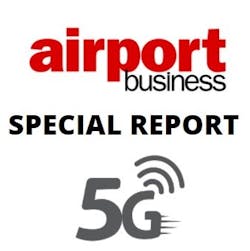
As telecommunications companies, airlines and the FAA battle over the widespread deployment of 5G and its impact on aviation, a lot of people in the industry have questions as to what’s at the heart of the issue and what can be done to resolve it.
Thomas Neubauer, vice president of innovations at TEOCO spoke with Airport Business to address the big issues at hand and explain what and how airports could be impacted by the rollout.
Why is 5G such an issue for aviation?
It’s not 5G, but the spectrum it’s being used on. Neubauer says 5G in the U.S. can be deployed at different frequency band: 700MHz, 850MHz, 1.9GHz, 2.5GHz and now in the C-band (3.7 – 3.98GHz).
Neubauer says only the latter is causing these interference problems with the altimeter radar given its vicinity to spectrum of altimeter radar in aircraft. Altimeter frequency filters aren’t very selective, so there are issues created with the new spectrum.
Telecommunications companies have complied with the rules set down by the FCC, but the altimeter filters can be impacted. There could be issues, but as it stands, there isn't evidence as to how widespread the issue will be, if any.
If 40 other countries have deployed 5G without issues, what’s wrong in the U.S.?
The spectrum being used in the U.S. is different than what’s used in other places. Filters in other parts of the world have more than a 10 percent difference between then as compared to roughly 5 percent in the U.S. system.
Europe is investigating the same issue, but Neubauer says they haven’t turned on 5G like the U.S. has. The U.S. is ahead of the curve with 5G compared to Europe, so this is the first big challenge of the technology.
People have 5G now and it doesn’t impact the airports. How is this different?
The majority of 5G is currently running in a much lower frequency band. Neubauer said AT&T and Verizon spent $70 billion on the project is it provides a wider spectrum range to handle a lot more data.
Will banning 5G within 2 miles of an airport solve the problem?
Not necessarily. Neubauer says this is a case-by-case issue. Interference depends where 5G antennas are located around an airport.
There’s no basis for a 2-mile range. It could be too much at one airport or not enough at another. It depends on the network layout and surrounding environment.
Neubauer said the discussions happening in the media are based on assumptions. There is information available now to model what the impact could be and where issues need to be addressed. Real world evidence of issues need to be identified and addressed.
Which airports are the most at risk of having issues with this deployment?
It depends on the location of cell towers and flight paths. For example, if you have a cell tower three miles away pointing towards the airport, the arriving planes may have challenges. Neubauer said the cell towers are designed for ground operations and find evidence of how strong these signals are working with different landing patterns.
So do we have to wait for the system to turn on to see the issues?
No. Neubauer said you can forecast issues prior to the system going live. We know how the signals propagate and they have access to information on how they will be turned on. We know the location of the antennas, where they’re pointed, their power and the flight corridors.
All this information can be put together to determine if an airport will have issues with the spectrum and what needs to be done to mitigate it.
If an airport finds an issue with the new 5G spectrum at their airport, does this mean they will never get to use the technology operationally?
No. Neubauer said it’s a question of which frequency band you’re using for 5G. It might not allow speed like the new spectrum allows, but it will allow plenty of other usages.
How do we fix this and how long will it take?
Neubauer said if there’s a will to address this issue, there is a way to fix it. Systems and technology exist now to get the evidence of issues and address them. If there’s willingness to address the issue now and gather evidence, issues could be determined in a matter of weeks.
What do airlines and airports need to do now to make sure that we’re prepared?
Neubauer suggests looking into the details. Find evidence of where this is an issue based on the network layout.
About the Author
Joe Petrie
Editor & Chief
Joe Petrie is the Editorial Director for the Endeavor Aviation Group.
Joe has spent the past 20 years writing about the most cutting-edge topics related to transportation and policy in a variety of sectors with an emphasis on transportation issues for the past 15 years.
Contact: Joe Petrie
Editor & Chief | Airport Business
+1-920-568-8399
>> To download the AviationPros media kits, visit: Marketing Resource Center
>>Check out our aviation magazines: Ground Support Worldwide | Airport Business | Aircraft Maintenance Technology
